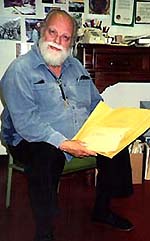
![]()
February 10, 2003
In Memoriam
UCSC biographers note
legacy of late Lou Harrison
By Scott Rappaport
 |
| Lou Harrison displays the first gift to his archive in Special
Collections at the University Library in 1991. Photo: Rita Bottoms |
Musical icon Lou Harrison passed away on February 2 while traveling to Columbus, Ohio, for a major festival featuring his music. The 85-year-old composer was a resident of Aptos since 1953, one of the founders of the Cabrillo Music Festival, and a generous donor to UCSC, where his archive resides.
Harrison died of a heart attack in Lafayette, Indiana.
Internationally recognized for his highly inventive and original work,
Harrison was the last living link in a tradition of American experimental
music that includes Charles Ives, Henry Cowell, Virgil Thomson, and John
Cage.
"I think of his legacy in three broad areas," noted Harrison's
biographer and UCSC professor of music Leta Miller. "He is most well-known
for his fusion of Asian and Western musical styles and instruments. The
second area is percussion music and the development of new instruments.
Thirdly, he made a major contribution in tuning studies--he often required
fixed-pitch instruments such as keyboards to be retuned in order to produce
a richer palate of intonation color."
Miller and UCSC music professor Fredric Lieberman coauthored Lou Harrison:
Composing a World, a biography published by Oxford University Press
in 1998. They have just completed a second book that Miller said should
be out by the end of the year. Both books come with compact disc recordings
containing unique performances of Harrison's music.
Harrison composed for percussion ensembles beginning in the 1930's. Such
ensembles are now standard in music departments, but were novel at the
time. He would utilize old auto brake drums and oxygen tanks in compositions
and was always looking for new and innovative instruments.
"Lou would go fishing in junkyards for brake drums or go into a
nursery and tap on flower pots to test the different pitches," Miller
noted. "He joined up with John Cage for percussion ensemble concerts
in the '30s and 40's. Later he made novel instruments, such as a metallophone
that he built by cutting coffee cans to different lengths."
Miller added that Harrison considered musical composition an intriguing
game, constructing his own rules that he was not allowed to break.
"He developed rules for each piece and strictly followed them, and
he didn't allow himself to cheat," Miller said. "Interestingly,
a lot of his music sounds improvisatory, but underneath it is a rigid
skeletal structure. The idea was to limit an overactive imagination. 'What
can I do within these constrictions?' Lou would ask himself."
Harrison was also the ultimate renaissance man. He was a published poet,
a painter, dancer, and calligrapher. He was an advocate of bio-diesel
fuel, kenaf (a natural fiber that could be used as an ecological alternative
to paper), and an expert in American sign language. He additionally designed
an ecologically-friendly straw-bale house in Joshua Tree that was used
as a personal retreat in his final months.
Harrison was also an outspoken political activist and strongly committed
to gay rights. In 1971, he composed a puppet opera, Young Caesar,
that focused on a gay love affair of Julius Caesar.
In a recent article in the Bay Area online journal Classical Voice,
Lieberman noted: "For me, Lou inspired not only through his music,
with its continuous search for beauty heedless of current styles or fads,
but also through his contagious enthusiasm, generosity and love. Seldom
would I come away from a visit to Lou's Aptos home without the exciting
feeling of having learned something remarkable, whether about music, architecture,
politics, or literature. Lou filled his place in the world fully and energetically--it's
hard to imagine what the world will feel like without him."
Harrison leaves behind a legacy of more than 300 compositions. Over the
past decade, his music was frequently featured in San Francisco Symphony
programs and recorded on the San Francisco record label New Albion.
UCSC Library head of Special Collections Rita Bottoms said that the university
will have Harrison's complete archives.
"Right now we have many of his scores, correspondence, clippings, programs, and artwork," Bottoms noted. "We are a focal point for a lot of Lou Harrison research. He was an incredible poly-artist. It's so hard to believe he's gone."